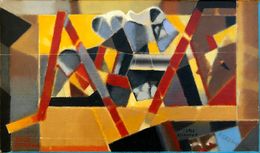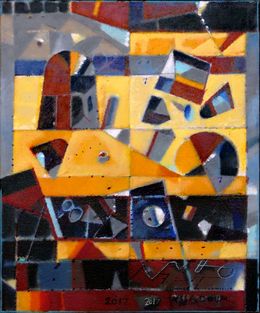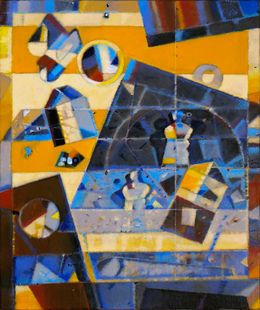
Presentation
Known by his first name, Assadour was born in Beirut (1943), but left Lebanon at the age of eighteen. He spent the summers of 1962, 1963 and 1964 in Perugia where he studied at the Pietro Vanucci Accademy. After that he went to Paris, and from 1964 to 1970 studied at the Ecole Nationale Supérieure des Beaux-Arts under the supervision of Coutaud.
Assadour is an active member of many institutions connected with the arts. He was on the committee of the Salon de Mai from 1974 to 1977, and a member of La Jeune Gravure Contemporaine from 1975 to 1979. Since 1984 he has been on the committee of Les Peintres Graveurs Français.
He has won many international awards: the Gold Medal at the Terza Biennale Internationale della Grafica d'Arte, Florence (1972); the Silver Medal at the Biennale Internationale de l'Estampe, Epinal, France (1973); the First Prize at the Biennale de Givet (1975), the President of the town of Crakow Award at the International Print Biennale, Poland (1980); and Honourable Mention at the Norwegian International Print Biennale, Frederikstad, Norway (1980), the Medal of Honour at the Male Formy Grafiki, Lodz, Poland (1981), the Museum of Modern Art Award, Lubljana, Yugoslavia (1983), and the Grand Prix de la Ville de Paris (1984).
Assadour has illustrated many books and publications including L'Affaire Lemoine, Paris, 1968-69; Fragment N'3, Liechtenstein, 1972; La Vecchiaia Nevica, Milan, 1978; Ombre, Luxembourg, 1976; L'Oiseleuse, Paris, 1978, and many others.
He has held many exhibitions; in Paris, at the Galerie La Pochade (1971), Galerie Sagot-le-Game (1977, 1983), Galerie du Dragon (1986) and Galerie Faris at the FIAC (1986); in Rome, at Galleria L'Arco (1980) and Galleria II Millennio and in Brussels at the Galerie La Taille Douce (1972). He has also exhibited in Luxembourg, Amsterdam, West Germany, Tokyo and Taiwan. He participated regularly in the Salons of the Sursock Museum between 1962 and 1966.
Assadour lives at present in Paris.
Article by Nohad Salemeh
The strangeness of a universe peopled with mythical characters, centaurs, sorcerers adjoining a space filled with a bric-à-brac of numbers, signs, bits of machinery, disjointed elements; it is the fusion of science and of fiction, or perhaps an imposition of the rational in order to fix the irrational, to give it concrete form. Assadour proposes a journey to us that is beyond our geographical present, outside the space in which we live and beyond even the space in which we dream; it is a voyage that cuts us off in a fabulous interval where time and duration are excluded, an expedition that forms the artist's central knot of legend and defines him as the geometrician of the third space.
Assadour is an artist who thinks his dream but who equally dreams his reflection. In this sense, his almost narrative symbolism set in the context of improvised tales covering the surface of his canvas – this symbolism is rather in the spirit of legend, whereas his rather cerebral subject matter brings a fresh viewpoint to the science of interrogation and this in the context of psychoanalysis. Indeed, Assadour attempts to pursue the dream, to seize it and sew it together again the better to reconstitute it in all its deceptions and its surprises. There is, too, a new vision where technique is concerned; in his watercolors, notably, the passage from geometric touches (squares, spheres, demi-spheres) to more fluid brush-strokes that dissolve in winding coils. Far from masking the linearity, the color reinforces it and along with the tenderness of the forms brings expressiveness and rigor. With all its intermediate range of pinks, blues and grays, the color creates new legendary and lyrical “traps" here and there by virtue of its very fluidity. In other words, the line resulting from a synchronization of the felt and the thought renounces its tension to dissolve into a lyric dimension; and the touches of color displayed in all their poetry seem to take on a precise function: to render beautiful these randomly gathered materials, these discarded objects, the debris waiting to be reconstituted that fills Assadour's work and has its own name: scar tissue of a city.
Article by Fiona Dunlop
...Unraveling the knots of Assadour's esoteric universe is like counting grains of sand. Its very essence is a never ending enigma and a frustrating one in that his images are scattered with innumerable clues, some identifiable others seemingly private codes. They appear fleetingly, silently, disturbingly, inviting comprehension but immediately retreating before definition...
The artist pushes our powers of analysis to the limit, leaving us feebly intoning "poetic" "mysterious" "timeless" or similar words to the same equivocal effect. He is the master of contradictions, of innuendos of ambiguities, of paradox, managing to create images which amalgamate opposites, are neither one thing nor the other, but ultimately catalyze both peoples into a distinct sensation, that uneasy sensation of the unknown.
Order/chaos; construction/destruction; lightness/darkness; past/future; optimism/pessimism; desert/city; North/South; East/West; Assadour's game of opposites is eternal and infinite, and he knowingly draws us through it by the fine point of his graphic instrument, occasionally letting us stumble in the shadow of a symbol, than again leading us towards an ever-receding horizon.
...And then the human figure enters the stage: unreal, puppet like, naive, observing his surroundings, balancing his hoop although he is perhaps past the age of play, still nostalgic for his youth. At other moments he is barely visible, a fleeing figure disappearing through a doorway, illusory, the fame of hide and seek continues. Identity unknown. Of no fixed abode. A creature of the fourth dimension? A clockwork toy or a protype for a new civilization? He remains solitary, aloof, and separate from his environment, overpowered but the suffocating silence which reigns while the red dust settles and the sands shift and the sirocco blows...
A pyramid, a half-moon, a polygon, a cluster of number, a stylized (doll's) house, a diagonal line with a fixed point, a glimpse of a brick wall, a (tantric?) circle: the guessing game begins again, we have come full circle, Assadour has added another cipher.


Recomposition II
Assadour Bezdikian
Painting - 33 x 41 x 1 cm Painting - 13 x 16.1 x 0.4 inch
$4,995




Personnages polychromes
Assadour Bezdikian
Painting - 50 x 60 x 0.5 cm Painting - 19.7 x 23.6 x 0.2 inch
Sold

Discover our selections of works by artists
What are their 3 main works?
What is Assadour Bezdikian’s artistic movement?
When was Assadour Bezdikian born?

